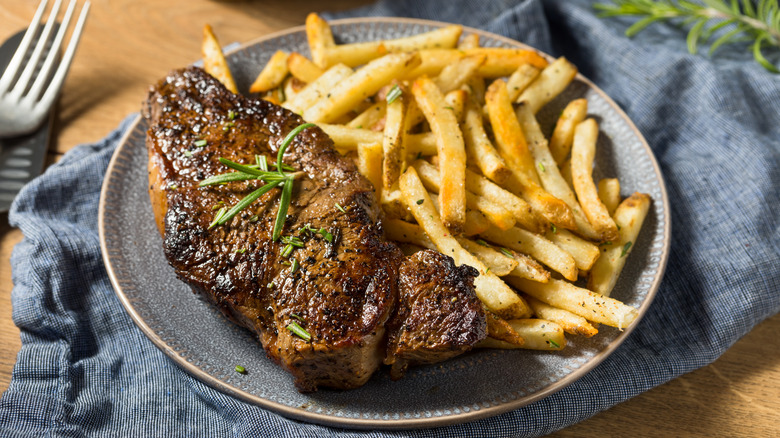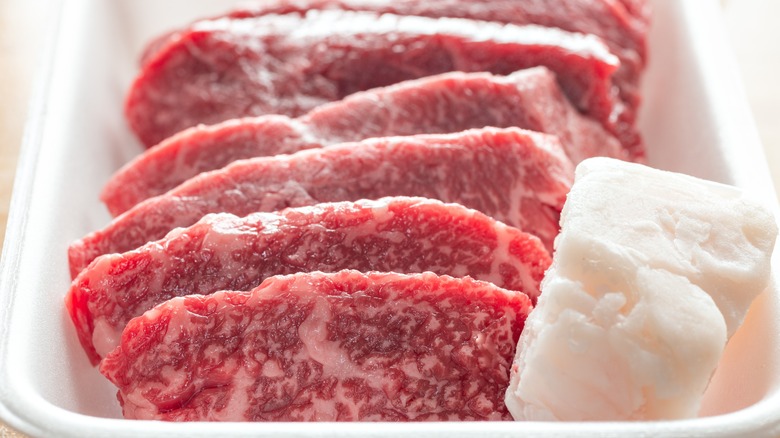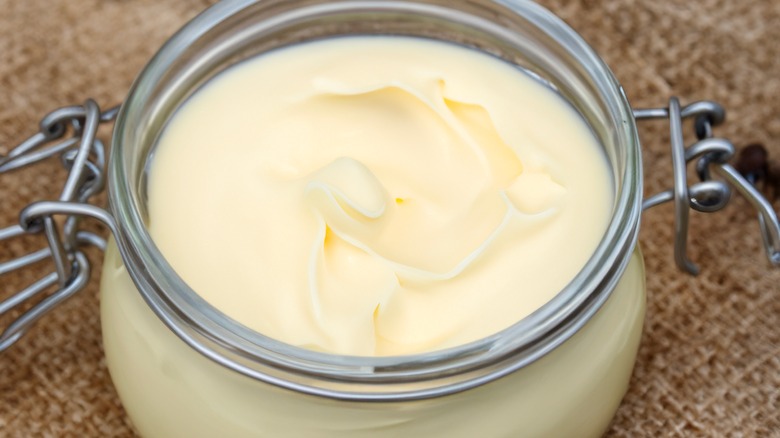The Butcher Shop Find You Need For Restaurant-Quality Steak And Sides
There are plenty of methods for cooking a great piece of steak, from quickly grilled to slow sous vide, not to mention the increasingly popular technique to perfectly reverse sear a steak for crispy, juicy results. But if you love a tasty, evenly caramelized crust, then it's hard to beat a pan-seared steak, basted in a little butter. Until, that is, you've tried using beef tallow in place of butter to take your steak to almost restaurant-level perfection.
So what is beef tallow and how do you cook with it? Tallow is essentially beef fat that has been rendered and cooled into a solid block. Once commonly used as cooking grease, beef tallow, also known as beef dripping, boasts an extraordinarily rich, savory flavor. Indeed, it was once the fat of choice for McDonald's fries up until 1990, which many people of a certain age still fondly remember with great nostalgia.
While you might not find beef tallow in all supermarkets, the affordable fat is something you can get hold of in a tub from many butcher shops, farmers markets, or online, or even make yourself. And it's easy to use when cooking steaks as well as a variety of sides for a superior steakhouse-style dinner at home.
Tallow adds extra beefy flavor to steaks and sides
Cooking steaks in tallow isn't just about the full-flavored finish it gives the meat. Another advantage of using the fat to cook with is that it has a high smoke point of around 400 degrees Fahrenheit, which means you can cook any cut of beef at a high temperature to develop a beautiful crust. It can be used in the same way you'd use other cooking fats, such as oil or butter; just melt it in a hot pan to give a stunning sear and to envelop the steaks in an incredible beefy taste.
It's not just meat that benefits from the intensely savory flavor of tallow, either. You can also give sides, such as potatoes, an extra boost by cooking them in the rich animal fat. Try slicing russet potatoes into thin shoestring fries before cooking them in hot beef tallow on a baking sheet in the oven. Or roast fingerling potatoes in melted tallow, boiling and gently crushing them first for an extra-crunchy exterior.
You can also use beef tallow to elevate sauces or gravies to accompany steak. Combine beef fat and butter to add to a béarnaise sauce, enriched with eggs and fragrant with aromatic tarragon. Try adding it to a gravy made with beef broth, red wine, and aromatics for a flavorful sauce to pour over the steak and potatoes. Or if you're serving salad, you could make croutons fried in tallow as a crunchy topping.
How to make your own beef tallow at home
While you can sometimes buy beef tallow from butcher shops, it's also simple to make a supply in your own kitchen if you regularly roast beef; save the fat trimmings in the freezer each time until you have around three or four pounds, or else ask your butcher if they have trimmings you could take home. The process essentially involves rendering the fat down over a gentle heat, and then straining it through a fine mesh strainer or cheesecloth to remove any impurities.
Homemade beef tallow can be used straight away for cooking or poured into clean, sealable glass jars once it has cooled, which will become more solid and whiter in color. If you want to make a batch, it will happily last for around three months in a jar in the refrigerator.
If you're struggling to get hold of tallow, or you haven't cooked enough joints of beef to make your own, then you can improvise if you buy a cut of steak that has a large strip of fat. Hold the steak with the fat side down in the hot pan before you start cooking, so the fat can render down and provide a rich oil to flavor the meat. Or cut a little piece of fat off the raw steak and use it to rub across a hot pan or grill before cooking for a similar result.



